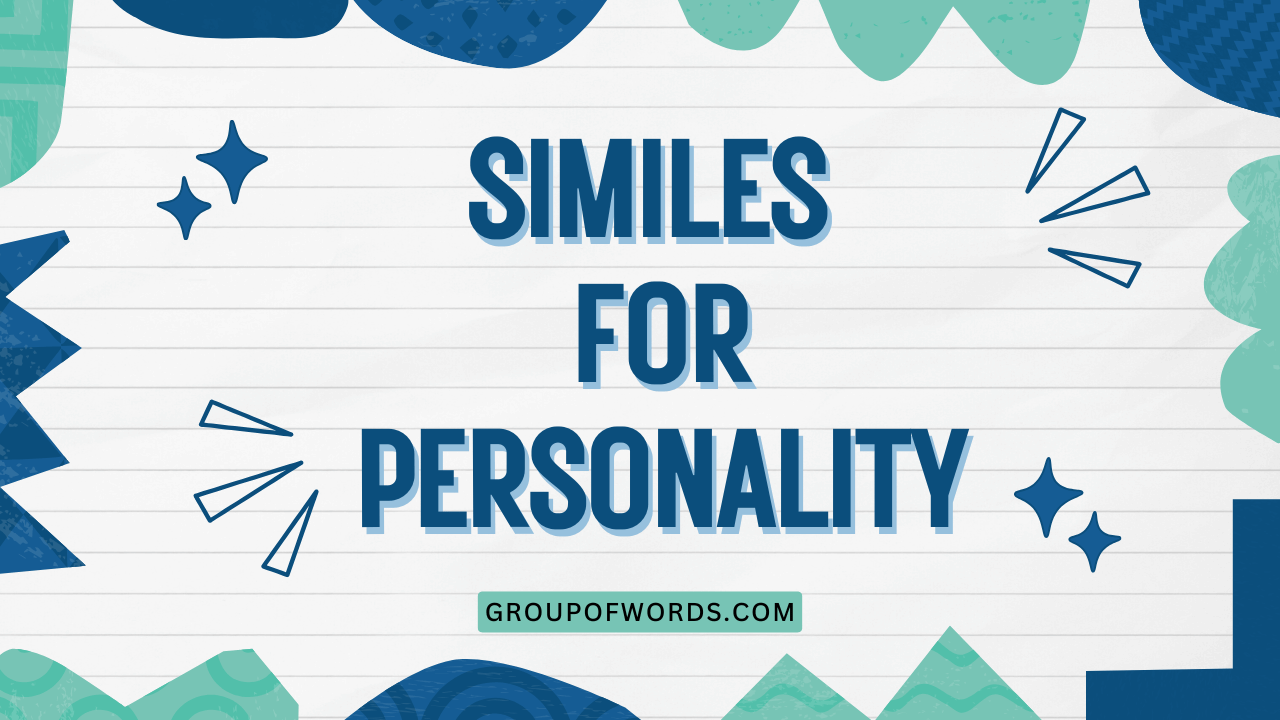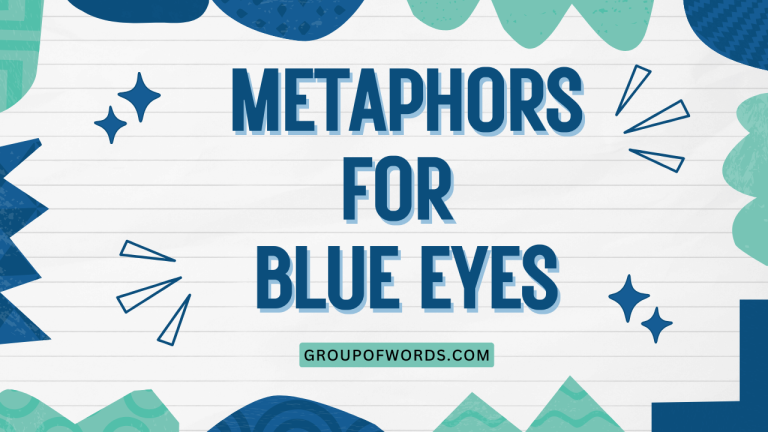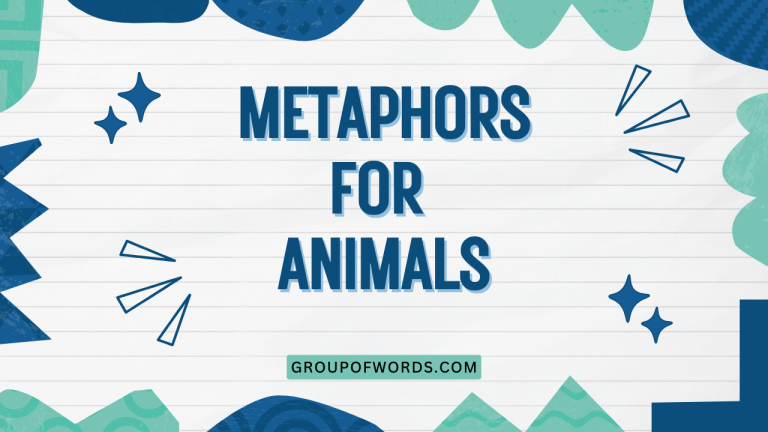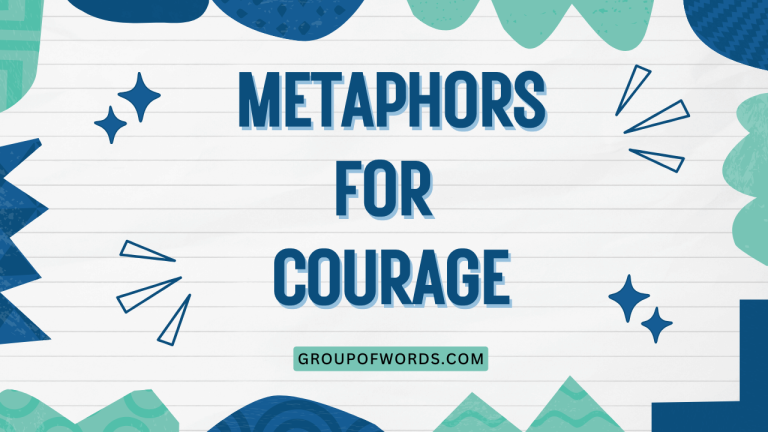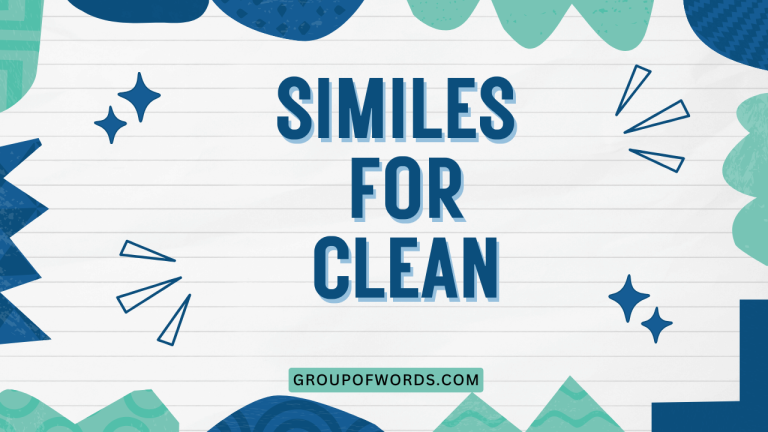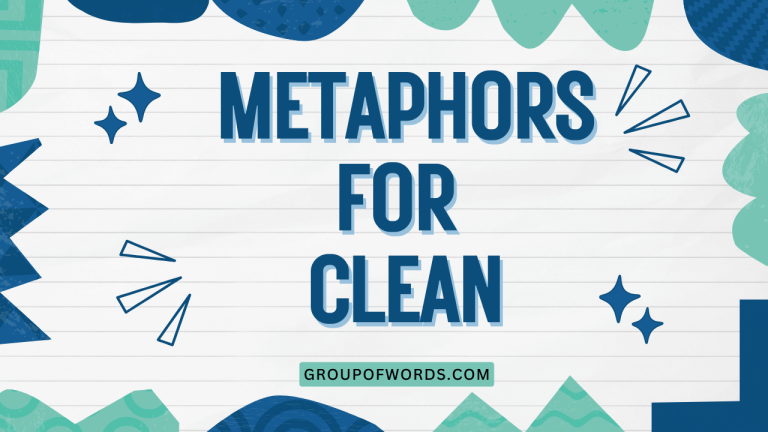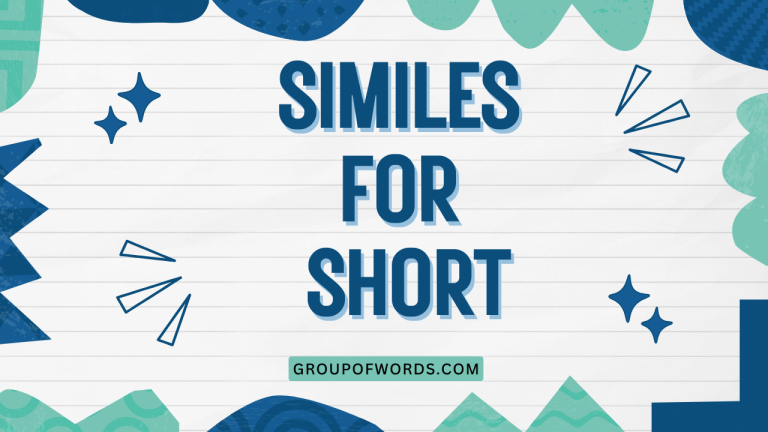Similes for Personality: Describing Character with Comparisons
Understanding how to use similes to describe personality traits is a powerful tool in the English language. Similes allow us to paint vivid pictures of character by drawing comparisons between a person’s qualities and familiar concepts.
This not only enhances our descriptive abilities but also makes our writing and speech more engaging and relatable. This article provides a comprehensive guide to using similes effectively to describe various personality traits, offering numerous examples, practical exercises, and helpful tips for both beginners and advanced learners.
Whether you’re a student looking to improve your essay writing, a writer crafting compelling characters, or simply someone interested in expanding your vocabulary, this guide will equip you with the knowledge and skills to use similes with confidence and precision. Mastering the art of using similes for personality will undoubtedly elevate your communication skills and make you a more articulate and expressive speaker and writer.
Table of Contents
- Definition of Simile
- Structural Breakdown of Similes
- Types of Personality Traits Described by Similes
- Examples of Similes for Personality
- Usage Rules for Similes
- Common Mistakes When Using Similes
- Practice Exercises
- Advanced Topics: Nuances and Subtleties
- Frequently Asked Questions
- Conclusion
Definition of Simile
A simile is a figure of speech that directly compares two different things using the words “like” or “as.” The purpose of a simile is to create a more vivid and descriptive image in the reader’s or listener’s mind by associating an unfamiliar concept with something familiar. In the context of describing personality, similes help us to convey the essence of a person’s character by comparing their traits to relatable objects, animals, or situations. A simile enhances understanding and adds color to language.
Similes are a type of figurative language, which means they are not meant to be taken literally. Instead, they rely on the imaginative connection between two dissimilar things.
This connection allows for a deeper and more nuanced understanding of the subject being described. For example, saying someone is “as brave as a lion” doesn’t mean they are literally a lion; it means they possess the characteristic of bravery associated with lions.
The effectiveness of a simile lies in its ability to evoke a strong mental image and convey a specific meaning concisely.
Structural Breakdown of Similes
The basic structure of a simile is quite simple, typically following one of these two patterns:
- A is like B
- A is as [adjective] as B
Where:
- A is the subject being described (in this case, a person’s personality).
- B is the object, animal, or situation to which the subject is being compared.
- like or as are the words that establish the comparison.
- [adjective] is used to emphasize a specific quality or characteristic shared by A and B.
Let’s break down a few examples:
- “He is as stubborn as a mule.” Here, “he” is the subject, “stubborn” is the adjective, and “a mule” is the object of comparison.
- “She is like a ray of sunshine.” In this case, “she” is the subject, and “a ray of sunshine” is the object of comparison.
Understanding this structure allows you to create your own similes to effectively describe personality traits. The key is to choose comparisons that are both apt and evocative, creating a clear and memorable image for your audience.
Types of Personality Traits Described by Similes
Similes can be used to describe a wide range of personality traits, which can be broadly categorized into positive, negative, and neutral traits. Each category includes various specific characteristics that can be effectively conveyed through similes.
Similes for Positive Personality Traits
Positive personality traits are desirable qualities that enhance a person’s character and interactions with others. These include traits like kindness, bravery, intelligence, and creativity.
Similes can be used to highlight these qualities in a vivid and memorable way.
Similes for Negative Personality Traits
Negative personality traits are undesirable qualities that can hinder a person’s relationships and overall well-being. These include traits like stubbornness, arrogance, and dishonesty.
Similes can be used to express these traits in a more nuanced and impactful manner.
Similes for Neutral Personality Traits
Neutral personality traits are qualities that are neither inherently positive nor negative but can be influenced by context and circumstance. These include traits like quietness, seriousness, and curiosity.
Similes can be used to provide a more descriptive and insightful understanding of these traits.
Examples of Similes for Personality
The following tables provide extensive examples of similes used to describe personality traits, categorized by positive, negative, and neutral characteristics. Each example illustrates how similes can effectively convey the essence of a personality trait through comparison.
Similes for Positive Personality Traits
This table showcases similes used to describe positive personality traits. These examples highlight how comparisons can enhance our understanding and appreciation of these admirable qualities.
The similes use a variety of objects, animals, and situations to create vivid and memorable images of positive character traits.
| Personality Trait | Simile |
|---|---|
| Kindness | She is as kind as a warm blanket on a cold day. |
| Bravery | He is as brave as a lion facing a pack of hyenas. |
| Intelligence | She is as intelligent as a seasoned professor. |
| Creativity | He is as creative as a painter with a blank canvas. |
| Patience | She is as patient as a saint waiting for enlightenment. |
| Honesty | He is as honest as the day is long. |
| Loyalty | She is as loyal as a dog to its owner. |
| Generosity | He is as generous as a philanthropist donating to charity. |
| Optimism | She is as optimistic as a child on Christmas morning. |
| Enthusiasm | He is as enthusiastic as a cheerleader at a pep rally. |
| Compassion | She is as compassionate as a nurse tending to the sick. |
| Resilience | He is as resilient as a tree bending in the wind. |
| Wisdom | She is as wise as an owl perched on a branch. |
| Diligence | He is as diligent as a bee collecting nectar. |
| Humility | She is as humble as a monk taking a vow of silence. |
| Courage | He is as courageous as a firefighter running into a burning building. |
| Grace | She moves as gracefully as a swan gliding on water. |
| Charm | He is as charming as a prince at a ball. |
| Wit | She is as witty as a comedian on stage. |
| Sincerity | He is as sincere as a heartfelt apology. |
| Hopefulness | She is as hopeful as a gardener planting seeds in spring. |
| Forgiveness | He is as forgiving as a parent comforting a child. |
| Joyfulness | She is as joyful as a child playing in the park. |
| Purity | He is as pure as the driven snow. |
| Piousness | She is as pious as a nun in prayer. |
| Tactfulness | He is as tactful as a diplomat negotiating peace. |
| Considerateness | She is as considerate as a friend offering support. |
| Patience | He is as patient as a teacher with slow learners. |
Similes for Negative Personality Traits
This table provides similes for describing negative personality traits. These examples illustrate how comparisons can add depth and impact to our understanding of these less desirable qualities.
The similes use a range of images to effectively convey the essence of negative character traits.
| Personality Trait | Simile |
|---|---|
| Stubbornness | He is as stubborn as a mule refusing to move. |
| Arrogance | She is as arrogant as a peacock displaying its feathers. |
| Dishonesty | He is as dishonest as a fox in a henhouse. |
| Jealousy | She is as jealous as a rival queen vying for power. |
| Greed | He is as greedy as a miser counting his gold. |
| Anger | She is as angry as a hornet disturbed in its nest. |
| Laziness | He is as lazy as a cat basking in the sun. |
| Pessimism | She is as pessimistic as a raven predicting doom. |
| Impatience | He is as impatient as a child waiting for candy. |
| Rudeness | She is as rude as a bull in a china shop. |
| Vanity | He is as vain as a starlet admiring her reflection. |
| Cruelty | She is as cruel as a wolf preying on a lamb. |
| Sarcasm | He is as sarcastic as a comedian delivering cutting remarks. |
| Selfishness | She is as selfish as a dragon hoarding its treasure. |
| Envy | He is as envious as a beggar watching a king. |
| Aggression | She is as aggressive as a shark hunting its prey. |
| Cynicism | He is as cynical as a detective solving a cold case. |
| Indifference | She is as indifferent as a stone statue in a park. |
| Recklessness | He is as reckless as a race car driver speeding on the track. |
| Malice | She is as malicious as a witch casting a spell. |
| Resentment | He is as resentful as a prisoner serving a long sentence. |
| Bitterness | She is as bitter as a lemon without any sugar. |
| Spitefulness | He is as spiteful as a child seeking revenge. |
| Apathy | She is as apathetic as a teenager watching TV. |
| Callousness | He is as callous as a surgeon performing an autopsy. |
| Deceitfulness | She is as deceitful as a con artist running a scam. |
| Greediness | He is as greedy as a pig at a trough. |
| Hatred | She is as full of hatred as a volcano is of lava. |
Similes for Neutral Personality Traits
This table provides similes for describing neutral personality traits. These examples illustrate how comparisons can add nuance and depth to our understanding of these qualities.
These traits are neither inherently positive nor negative, but similes can help convey a more specific impression.
| Personality Trait | Simile |
|---|---|
| Quietness | She is as quiet as a mouse in a library. |
| Seriousness | He is as serious as a judge in a courtroom. |
| Curiosity | She is as curious as a cat exploring a new house. |
| Shyness | He is as shy as a violet hiding in the grass. |
| Reservedness | She is as reserved as a diplomat at a formal event. |
| Independence | He is as independent as a lone wolf in the wilderness. |
| Practicality | She is as practical as an engineer designing a bridge. |
| Traditionalism | He is as traditional as a family celebrating old customs. |
| Modernity | She is as modern as a smartphone app. |
| Introversion | He is as introverted as a scholar lost in books. |
| Extroversion | She is as extroverted as a party host greeting guests. |
| Formality | He is as formal as a butler serving dinner. |
| Informality | She is as informal as a friend chatting over coffee. |
| Complexity | He is as complex as a puzzle with many pieces. |
| Simplicity | She is as simple as a straight line. |
| Cautiousness | He is as cautious as a squirrel crossing the road. |
| Boldness | She is as bold as a graffiti artist painting a mural. |
| Reflectiveness | He is as reflective as a pond mirroring the sky. |
| Spontaneity | She is as spontaneous as a summer rain shower. |
| Orderliness | He is as orderly as a librarian shelving books. |
| Adaptability | She is as adaptable as a chameleon changing colors. |
| Assertiveness | He is as assertive as a lawyer presenting a case. |
| Sensitivity | She is as sensitive as a flower wilting in the sun. |
| Detail-oriented | He is as detail-oriented as a watchmaker assembling a timepiece. |
| Big-picture | She has a big-picture view of the world, like a pilot viewing the landscape from above. |
Usage Rules for Similes
When using similes, there are several rules to keep in mind to ensure clarity and effectiveness:
- Use “like” or “as”: These are the key words that identify a simile. Make sure to include one of them to clearly establish the comparison.
- Compare dissimilar things: The strength of a simile comes from comparing things that are not obviously alike. This creates a more vivid and interesting image.
- Ensure the comparison is clear: The connection between the two things being compared should be easily understood. If the comparison is too obscure, the simile will lose its impact.
- Avoid clichés: Overused similes can sound unoriginal and stale. Try to come up with fresh and creative comparisons.
- Consider your audience: Choose comparisons that will be familiar and relevant to your audience. This will ensure that your simile resonates and is easily understood.
A well-crafted simile can significantly enhance your writing and speaking. By following these rules, you can create similes that are both effective and engaging.
Common Mistakes When Using Similes
Even with a good understanding of similes, it’s easy to make mistakes. Here are some common errors to avoid:
- Confusing similes with metaphors: A simile uses “like” or “as” to make a comparison, while a metaphor implies a comparison without using these words.
- Incorrect (Metaphor): He is a lion.
- Correct (Simile): He is as brave as a lion.
- Using clichés: Overusing common similes can make your writing sound uninspired.
- Incorrect (Cliché): She is as busy as a bee.
- Correct (Original): She is as busy as a project manager juggling multiple deadlines.
- Making unclear comparisons: The connection between the two things being compared should be obvious.
- Incorrect (Unclear): He is as mysterious as a doorknob.
- Correct (Clear): He is as mysterious as a locked room with no key.
- Using illogical comparisons: Ensure that the comparison makes sense in the context.
- Incorrect (Illogical): She is as tall as a mouse.
- Correct (Logical): She is as small as a mouse.
By being aware of these common mistakes, you can avoid them and use similes more effectively in your writing and speech.
Practice Exercises
Test your understanding of similes for personality with these practice exercises. Each exercise will help you identify and create effective similes to describe various personality traits.
Answers are provided at the end of each exercise.
Exercise 1: Identifying Similes
Identify the similes in the following sentences:
| Question | Answer |
|---|---|
| 1. He is as quiet as a church mouse. | as quiet as a church mouse |
| 2. She is a ray of sunshine. | (This is a metaphor, not a simile) |
| 3. He is like a rock in times of trouble. | like a rock |
| 4. She is as quick as a whip. | as quick as a whip |
| 5. The world is his oyster. | (This is a metaphor, not a simile) |
| 6. He is as cunning as a fox. | as cunning as a fox |
| 7. She is like a breath of fresh air. | like a breath of fresh air |
| 8. He is as steady as a mountain. | as steady as a mountain |
| 9. She is a night owl. | (This is a metaphor, not a simile) |
| 10. He is as blind as a bat. | as blind as a bat |
Exercise 2: Completing Similes
Complete the following similes with appropriate comparisons:
| Question | Answer |
|---|---|
| 1. He is as brave as a __________. | He is as brave as a lion. |
| 2. She is like a __________. | She is like a gentle breeze. |
| 3. He is as stubborn as a __________. | He is as stubborn as a mule. |
| 4. She is as bright as a __________. | She is as bright as a star. |
| 5. He is like a __________. | He is like a tower of strength. |
| 6. She is as graceful as a __________. | She is as graceful as a swan. |
| 7. He is as sly as a __________. | He is as sly as a fox. |
| 8. She is like a __________. | She is like a warm fire on a cold night. |
| 9. He is as strong as an __________. | He is as strong as an ox. |
| 10. She is as delicate as a __________. | She is as delicate as a flower. |
Exercise 3: Creating Similes
Create similes to describe the following personality traits:
| Trait | Possible Simile |
|---|---|
| 1. Kindness | She is as kind as an angel. |
| 2. Intelligence | He is as intelligent as a computer. |
| 3. Patience | She is as patient as a teacher with young children. |
| 4. Arrogance | He is as arrogant as a king on his throne. |
| 5. Shyness | She is as shy as a mouse hiding in its hole. |
| 6. Enthusiasm | He is as enthusiastic as a child on Christmas morning. |
| 7. Seriousness | She is as serious as a judge in a courtroom. |
| 8. Laziness | He is as lazy as a cat sleeping in the sun. |
| 9. Courage | She is as courageous as a firefighter running into a burning building. |
| 10. Optimism | He is as optimistic as a gardener planting seeds in spring. |
Advanced Topics: Nuances and Subtleties
For advanced learners, understanding the nuances and subtleties of simile usage can greatly enhance their writing and communication skills. This involves not just creating grammatically correct similes but also considering the cultural context, emotional impact, and overall effectiveness of the comparison.
One advanced technique is using similes to create irony or satire. By comparing a personality trait to something unexpected or contradictory, you can create a humorous or critical effect. For example, describing a corrupt politician as “as honest as a used car salesman” creates a satirical effect by highlighting the politician’s dishonesty through a common stereotype.
Another advanced concept is the use of extended similes. Instead of a single comparison, an extended simile develops the comparison over several sentences or even paragraphs, adding layers of meaning and detail. This can be particularly effective in descriptive writing, where the goal is to create a vivid and immersive experience for the reader.
Finally, understanding the cultural connotations of different comparisons is crucial. A simile that resonates in one culture may be confusing or even offensive in another. For example, comparing someone to a specific animal may have different meanings in different cultures. Therefore, it’s important to be aware of these cultural nuances and choose comparisons that are appropriate for your audience.
Frequently Asked Questions
Here are some frequently asked questions about using similes to describe personality:
- What is the difference between a simile and a metaphor?
A simile is a comparison using “like” or “as,” while a metaphor implies a comparison without using these words. For example, “He is as brave as a lion” (simile) versus “He is a lion” (metaphor).
- Why use similes instead of just stating the personality trait directly?
Similes add color, depth, and vividness to your descriptions. They help the reader or listener visualize the trait more effectively and make your writing more engaging.
- How can I avoid using clichés when creating similes?
Try to think outside the box and come up with original comparisons. Instead of using common phrases, consider specific examples or unique situations that relate to the personality trait you’re describing.
- Can a simile be too complex or obscure?
Yes, if the comparison is too difficult to understand or doesn’t make sense in the context, it will lose its impact and may confuse your audience. Aim for clarity and relevance.
- Are similes appropriate for all types of writing?
Similes are generally appropriate for creative writing, descriptive essays, and speeches. However, they may not be suitable for formal or technical writing, where clarity and precision are paramount.
- How do I choose the right comparison for a simile?
Consider the specific qualities you want to highlight and choose comparisons that effectively convey those qualities. Think about the associations and connotations that the comparison evokes.
- Can a simile be used to describe more than one personality trait at a time?
While it’s possible, it’s generally better to focus on one trait per simile to ensure clarity and impact. Trying to describe multiple traits in a single simile can make it confusing.
- How important is it to consider the audience when using similes?
It’s very important. Choose comparisons that will be familiar and relevant to your audience to ensure that your simile resonates and is easily understood.
Conclusion
Mastering the use of similes to describe personality traits is a valuable skill that can significantly enhance your communication abilities. By understanding the structure, types, and usage rules of similes, you can create vivid and engaging descriptions that bring your writing and speech to life.
Remember to avoid common mistakes, practice regularly, and consider the nuances of simile usage to further refine your skills.
As you continue to explore the world of similes, remember that creativity and originality are key. Don’t be afraid to experiment with different comparisons and find your own unique voice.
With practice and attention to detail, you can become a master of using similes to paint compelling portraits of personality.
